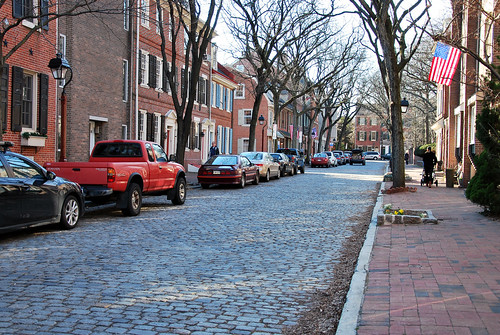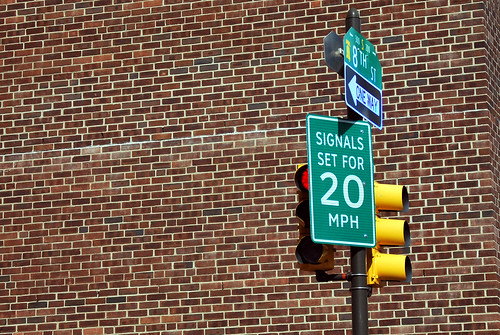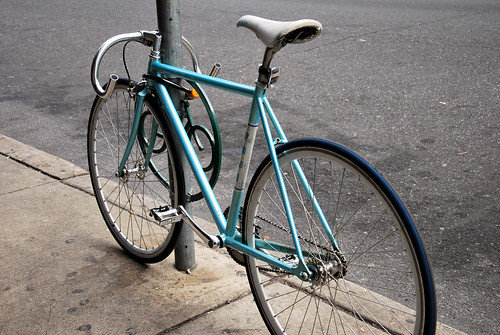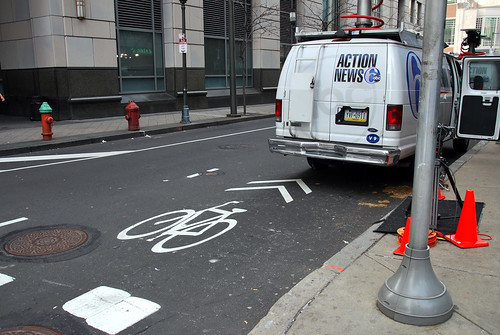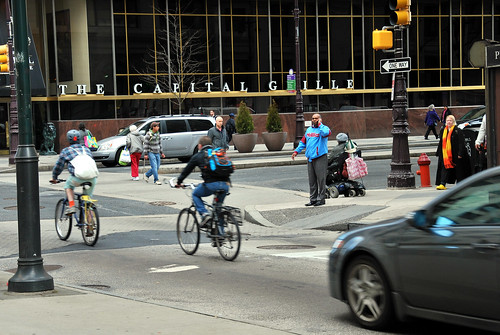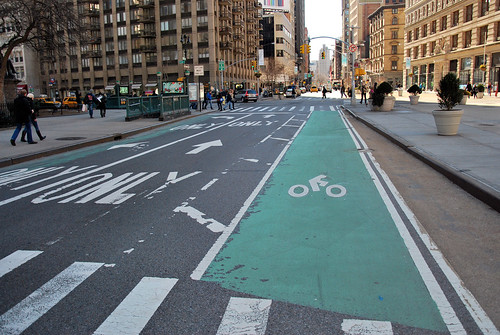NY and Philly on a Bike
When I was planning this trip, I had intended to spend as much of my time as possible in New York on a bike. Then everything else I still wanted to do and the cost of hiring a bike as opposed to gadding about on the subway got in the way. Renting a bike in NY is not cheap – this is a city that will benefit massively from its proposed bike share scheme.
Philadelphia was an eye opener. I hadn’t thought about cycling there, but after less than an hour ambling around in the centre on my first day, I really wanted to. The city is set out using the typical North American grid system with alternating direction one-way roads. Market Street is the main east-west road, along which the main shops and most of the tourist sites are spread. There’s a similar north-south road, Broad Street, also known as the Avenue of the Arts, with most of the city’s big sporting venues at the southern end. Downtown does spread out from these two roads, but the greatest concentration of shops and offices is on the blocks immediately abutting them.
As a result the area I was staying was remarkably peaceful. About five blocks south of Market, on the corner of 12th and Spruce, it had its share of speedy vehicles but was very residential, even cosy, in atmosphere. 12th is a former tramway, the tramlines left in the road as a nod to history - not a great feature for those on bicycles - but Spruce has an on-road bike lane running its entire length, with only one lane of parking on the opposite side of the street. The route in the opposite direction was one block south on Pine Street*. There are similar lanes going north and south too. From the sheer number of bicycles - of all ages, styles and levels of upkeep - I saw locked to railings, parking meters and bike hoops, I’d have said there were more than one set of lanes on each axis – but as I didn’t go very far north of Market Street or much beyond Broad I can’t be sure. 

Even where there aren’t overt markings, there’s a high level of riding. Pretty much all day there were bikes whizzing past on Spruce, and while those on Market tended to clump around business hours there were very healthy numbers of riders throughout the day. I had thought – correctly, as I checked when I got back – that riding on pavements in the US was illegal, but the high number of riders I saw doing it in all three cities I visited made me wonder. In fact, the DC bike share map has a rough outline of an area where it’s expressly forbidden to ride on pavements, suggesting that in other locations it’s tolerated at the very least.
One of the reasons cycling seems to work in Philly is the layout. A friend of mine said it was very English – unsurprising, given the city’s history – and while it does indeed have the cosiness of the old parts of London, Durham and Britain’s other ancient cities, the grid system makes it much easier to find your bearings and get around quickly. Away from the commercial crosshair and the museum quarter to the north-east of it, Philly’s streets are mixed-use and feel like part of one giant halfway-out-of-town neighbourhood.
The buildings are a combination of small businesses and mid-density residential blocks. If the streets were two-way it would feel a little tight for comfort, but as they’re all one-way there’s easily space for a bike lane, one lane of motor vehicles and a lane for parking on the far left. The parking on the wrong side and the closed-in feeling created by three- or four-storey buildings on either side acts as a natural speed limiter. Speed limits are 20mph on most of these roads, and even the very cool, busy, place-to-be South Street is ridiculously relaxed compared to the conditions I’d expect in a similar kind of place in London.
And while bikes are locked to lampposts, railings and anything sturdy and tall, as they always are in most towns, there is no shortage of proper cycle parking up and down Market and Broad, outside stores, near the small parks and squares scattered about Center City.
But nowhere’s perfect:
Bike hire starts as low as roughly $25 a day. This was at Frankenstien (sic) Bike Worx, where the owner will happily chat to any British visitor for hours about EastEnders (he was watching “a classic” featuring Ethel and Lou when I popped in, was very upset about Frank’s recent demise and hoped Pat would sort out Janine once and for all in the near future). Because I was there way before the tourist season started, he didn’t have any of his rentals ready for the year yet, but could have one for me the morning after next.
In Philly, the only people I didn’t see riding were little kids. There were helmets, bare heads, fancy hats and earmuffs. There were hipster threads, smart coats, comfy joggers and jeans. There were Bromptons. There were customised cruisers. There were slightly rusty road bikes. There were pelotons of police officers!
In Manhattan, people on bikes still fall into two rough categories: Posse types‡, and lycra warriors.
Both times I’ve been to New York in the past I’ve had vicious colds to distract me - the last one so bad a waiter told me in a kindly voice that I was actually green - but on neither occasion do I recall seeing people on bikes anywhere other than Central Park or getting in the way of wedding photos on Brooklyn Bridge. This time I saw them. Cycle ninjas hurling themselves across 5th in the pouring rain, the odd hipster rolling out of Stumptown Coffee (another quality PDX product) and riding off on his fixie, Americano in one hand - and a gaggle of lycra dudes who whizzed past in overly tight shorts on Sunday morning.
My hotel was in the Flatiron district. While the space in front of the Flatiron Building itself is brilliant – big bold green bike lanes bowling south down Broadway from Times Square, public seating and free wifi to boot – the rest of the area is lacking.
There are on-street lanes criss-crossing some of the quieter streets between Broadway and 2nd and 3rd Ave, but I found them all by accident – as was the case with the partly-separated bike tracks and bike-specific traffic lights on 8th and 9th Avenues, which I passed walking across town to visit the High Line park. As the infrastructure increased, so too did the number of bikes I saw locked up, but the number of riders was much lower. Admittedly my visit falling over a weekend meant the number of commuters I was likely to see was reduced to almost nothing, but after Philly it seemed disappointing.
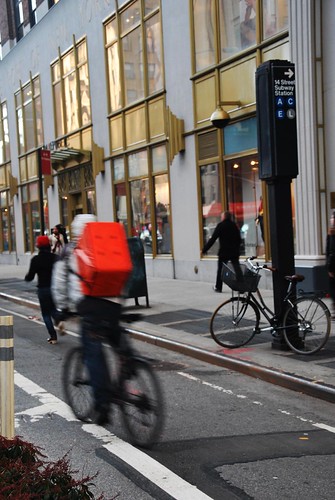 To ride the direct route from my hotel on 30th at 5th up to the Rockefeller Center, you have to ride the wrong way up the one-way terror that is 5th or mix with the big guns on Park Avenue one block west. For a safer, less hair-raising route, you need to ride several blocks east and use the northbound lane on 1st – outside parked cars and shared with other vehicles, but wider than the other lanes with signs exhorting would-be overtakers to pull into the next lane out – or head west and use the 9th Avenue bike track (or the 8th Avenue track; despite big arrows suggesting bikes should move in the same direction as the rest of the traffic, I saw numerous riders on both roads going the wrong way).
To ride the direct route from my hotel on 30th at 5th up to the Rockefeller Center, you have to ride the wrong way up the one-way terror that is 5th or mix with the big guns on Park Avenue one block west. For a safer, less hair-raising route, you need to ride several blocks east and use the northbound lane on 1st – outside parked cars and shared with other vehicles, but wider than the other lanes with signs exhorting would-be overtakers to pull into the next lane out – or head west and use the 9th Avenue bike track (or the 8th Avenue track; despite big arrows suggesting bikes should move in the same direction as the rest of the traffic, I saw numerous riders on both roads going the wrong way).
I knew from pre-trip research that there is more to New York’s cycle facilities than this. In the past year there’s been the almighty row over Brooklyn’s Prospect Park West separated cycle lane, and a quick look at the Upper West Side on Google Earth, especially near the American Museum of Natural History, shows those bright green lanes on the left of the road (to reduce the risk of dooring). The area around Moby’s vegan tea shop is, as befitting an area of the Lower East Side popular with hipsters, covered in dedicated lanes. But to me, the Flatiron section of New York strikes me as very like London: Good routes exist, but at the moment you still have to know where to look, and where you’re going once you leave them.
In the design guidelines for London facilities, pooling on road and pavement surfaces is a Bad Thing. Efforts to make sure they can and do drain are apparently paramount. In NY, pooling comes as standard. Pavements are a combination of concrete slabs and paving stones; roads are concrete and tarmac, with big metal plates in some places, especially around junctions. Neither is particularly smooth. I learned not to walk faster than snail’s pace with a hot drink in my hand because any time I took my eye off the ground to take a slurp, I invariably tripped and sloshed coffee, bad tea or hot chocolate down myself. But where there is bike infrastructure, the surfaces are good. When the markings are put in there seems to be an effort to do more than just patch up the worst of the potholes, making riding with a coffee slightly less risky than walking with one for people like me. Maybe that hipster was onto something?
What New York has going for it is, surprisingly enough, scale. The buildings may be vast, but so are the roads, and as the pedestrianisation of Times Square and the addition of miles and miles of bike lanes across the city has already shown, the traffic isn’t hurt at all by the removal of a few lanes to improve facilities for other users. Take a lane from Park Avenue in each direction and it might cause slightly more of a squeeze, but as most roads in Manhattan are one-way in alternate directions, with through routes well signed when that isn’t the case, the grid could easily absorb even that kind of change in traffic flow. Make it a bit easier to find and perhaps next time I won’t resort to the subway to get around.
* The Bicycle Coalition of Greater Philadelphia is continuing to push for more of the sort of infrastructure that impressed me. Last year they put together a report showing the “build it and they will come” effect the Spruce and Pine lanes have had, especially on the indicator species known as women.
‡Also known as cycle ninjas. From The Raging Peloton, Iain Sinclair (definition about halfway down)

